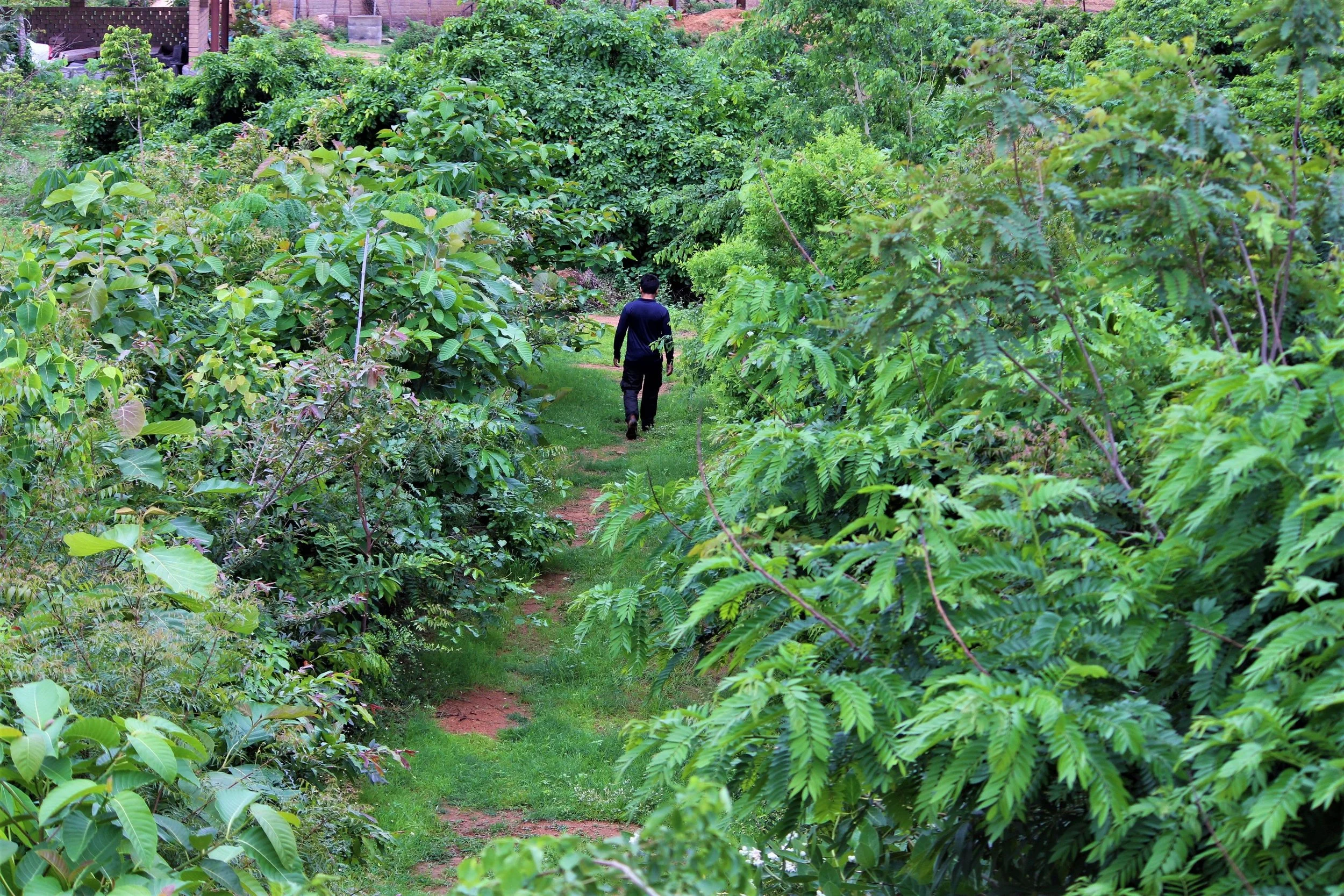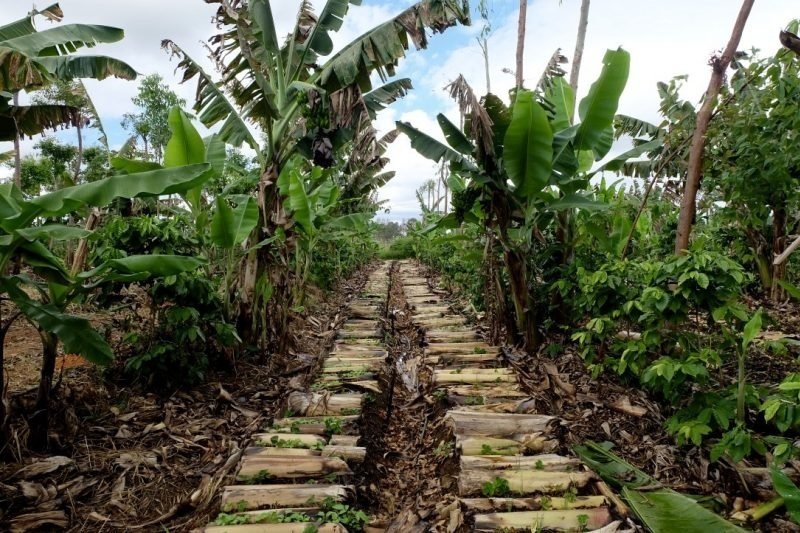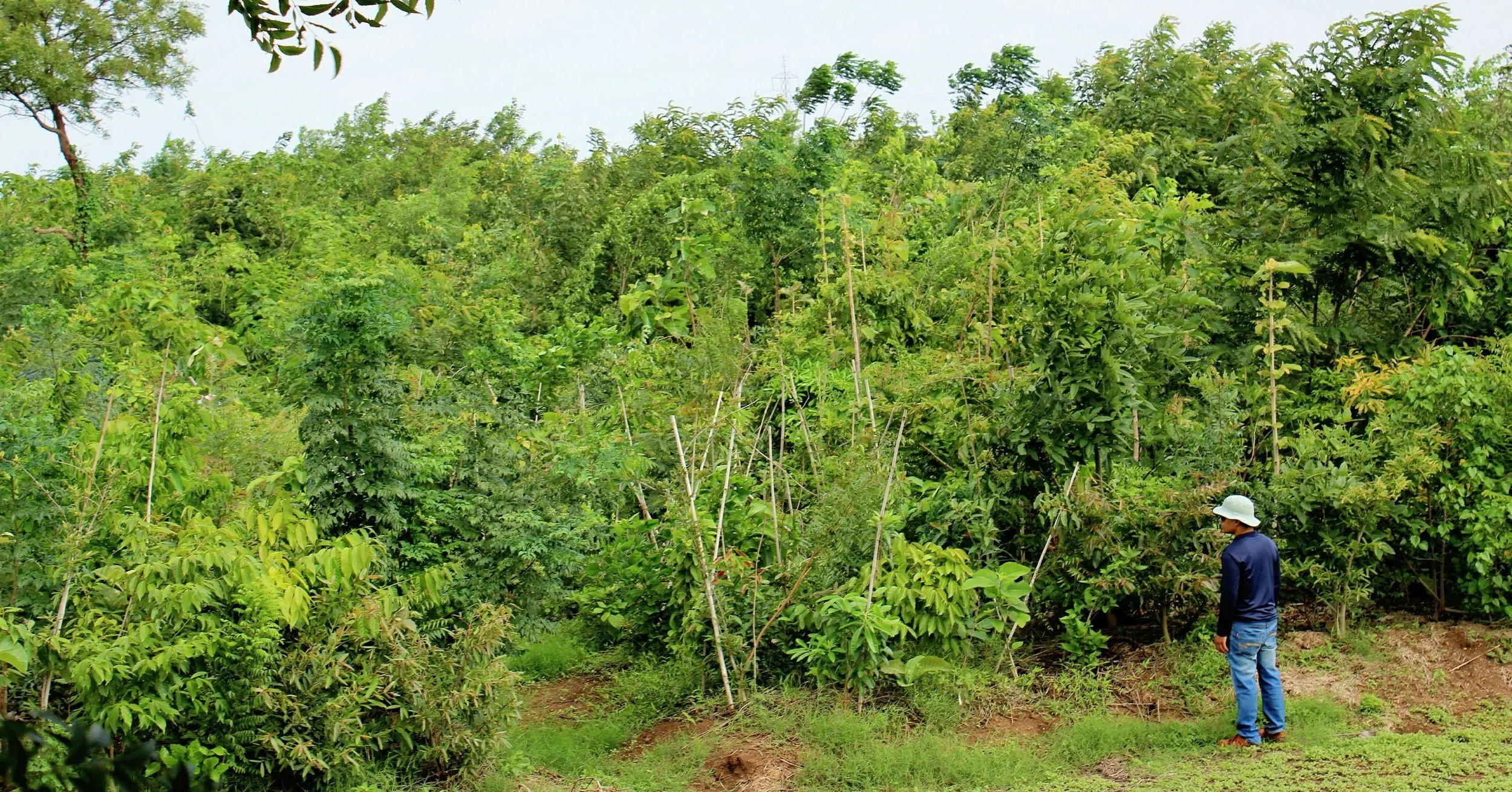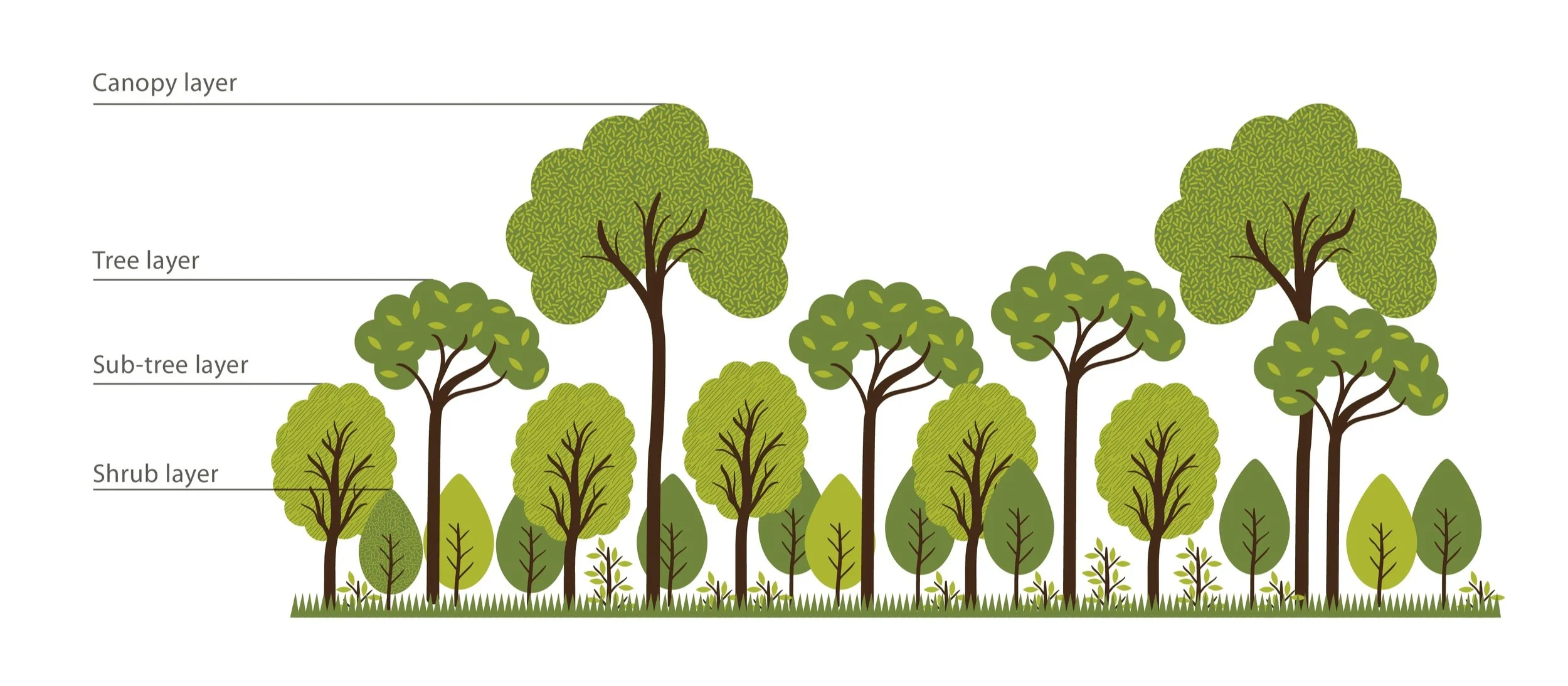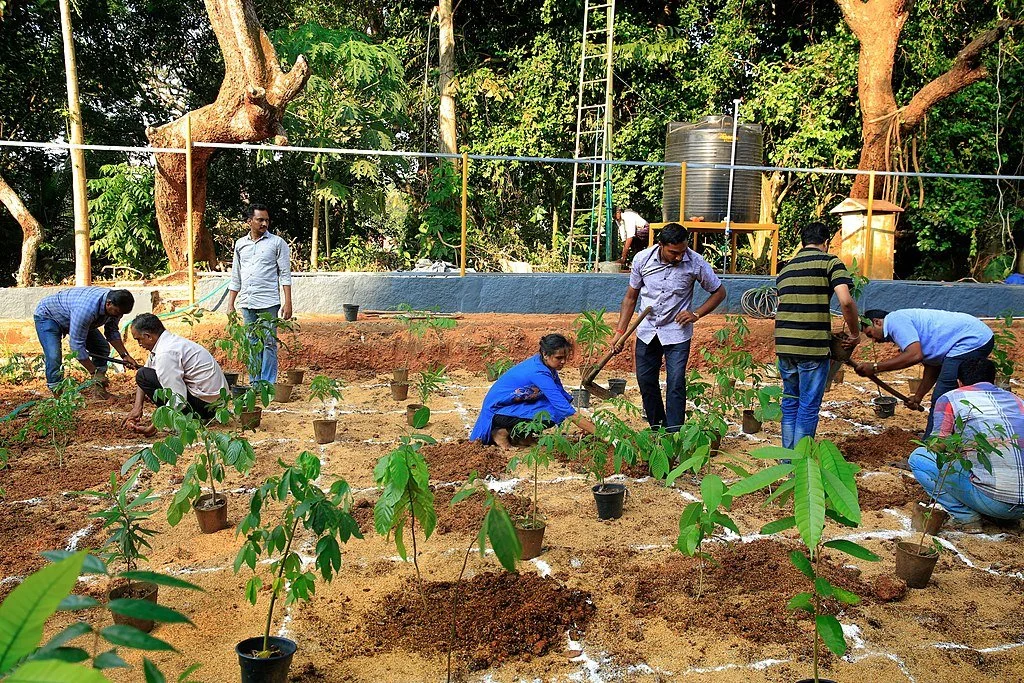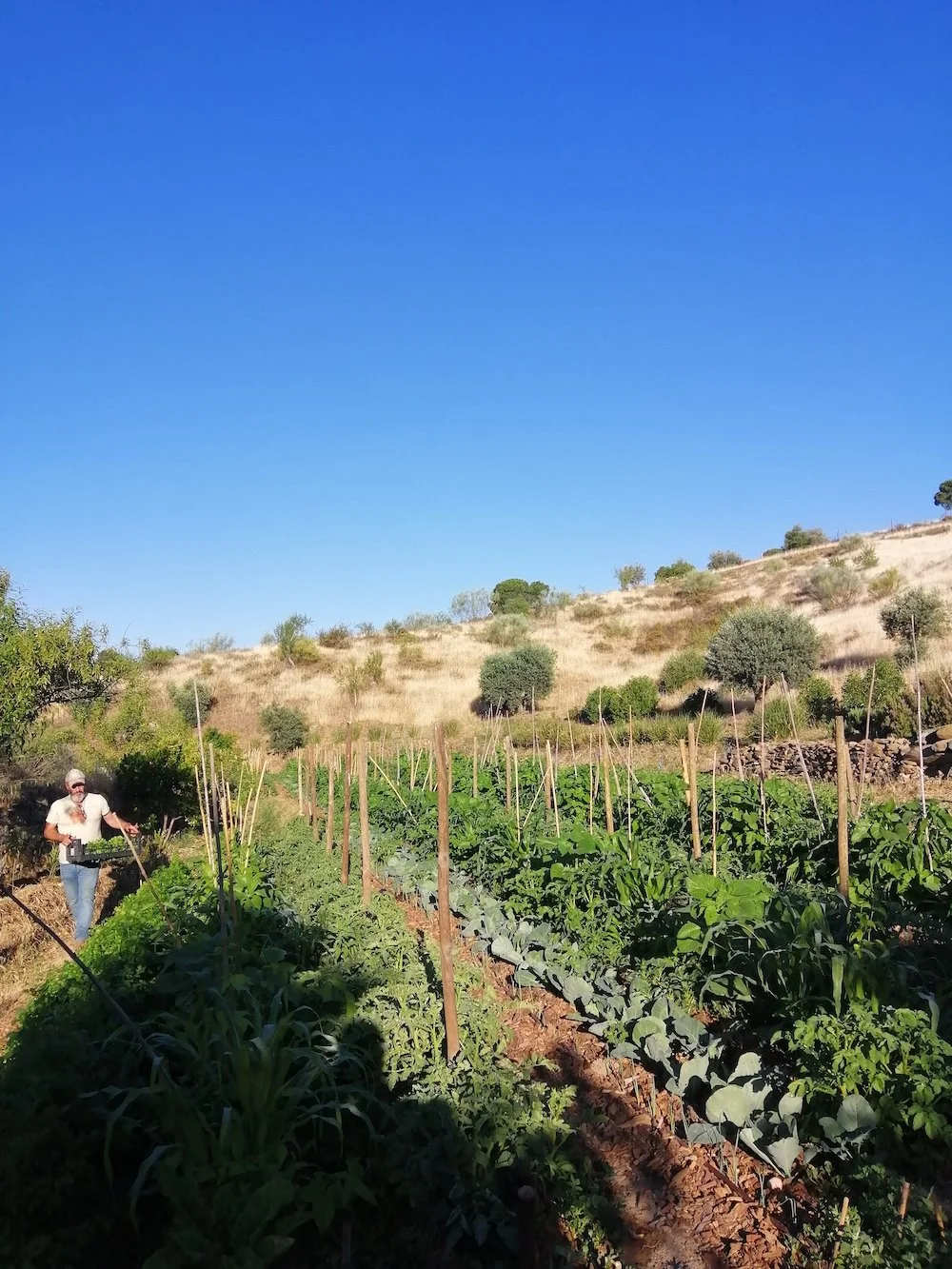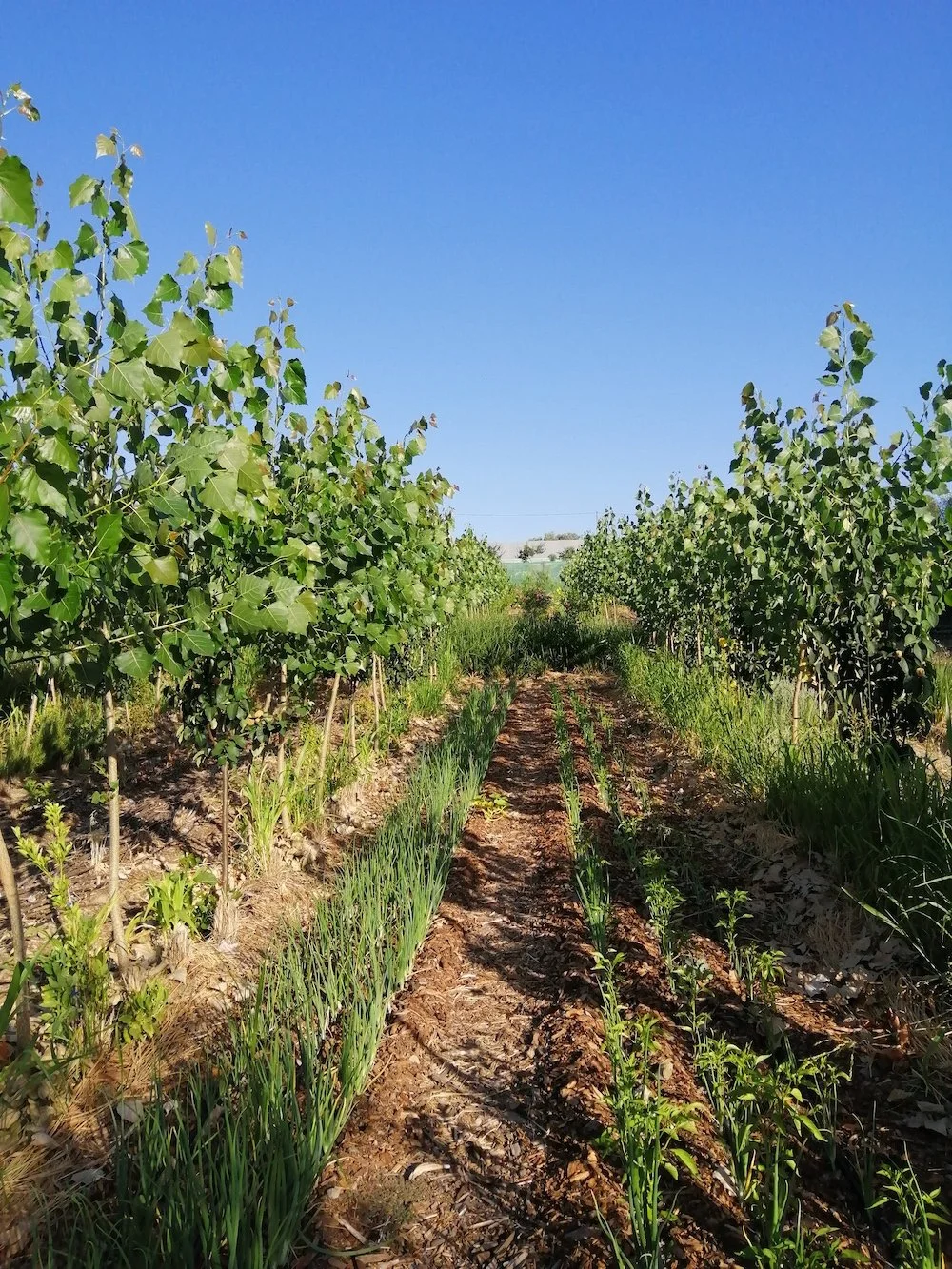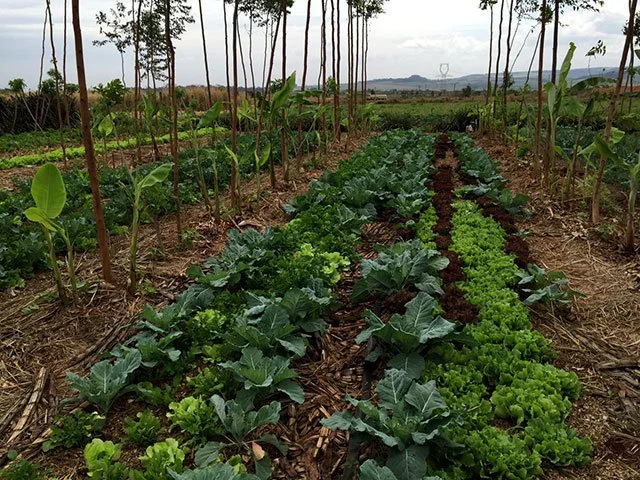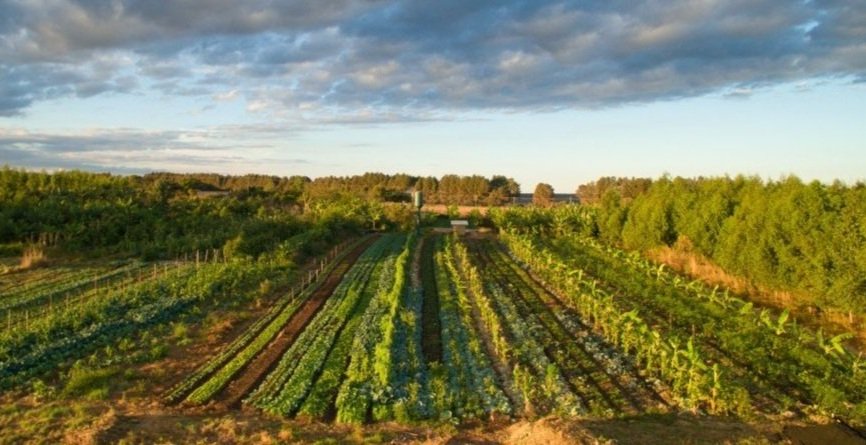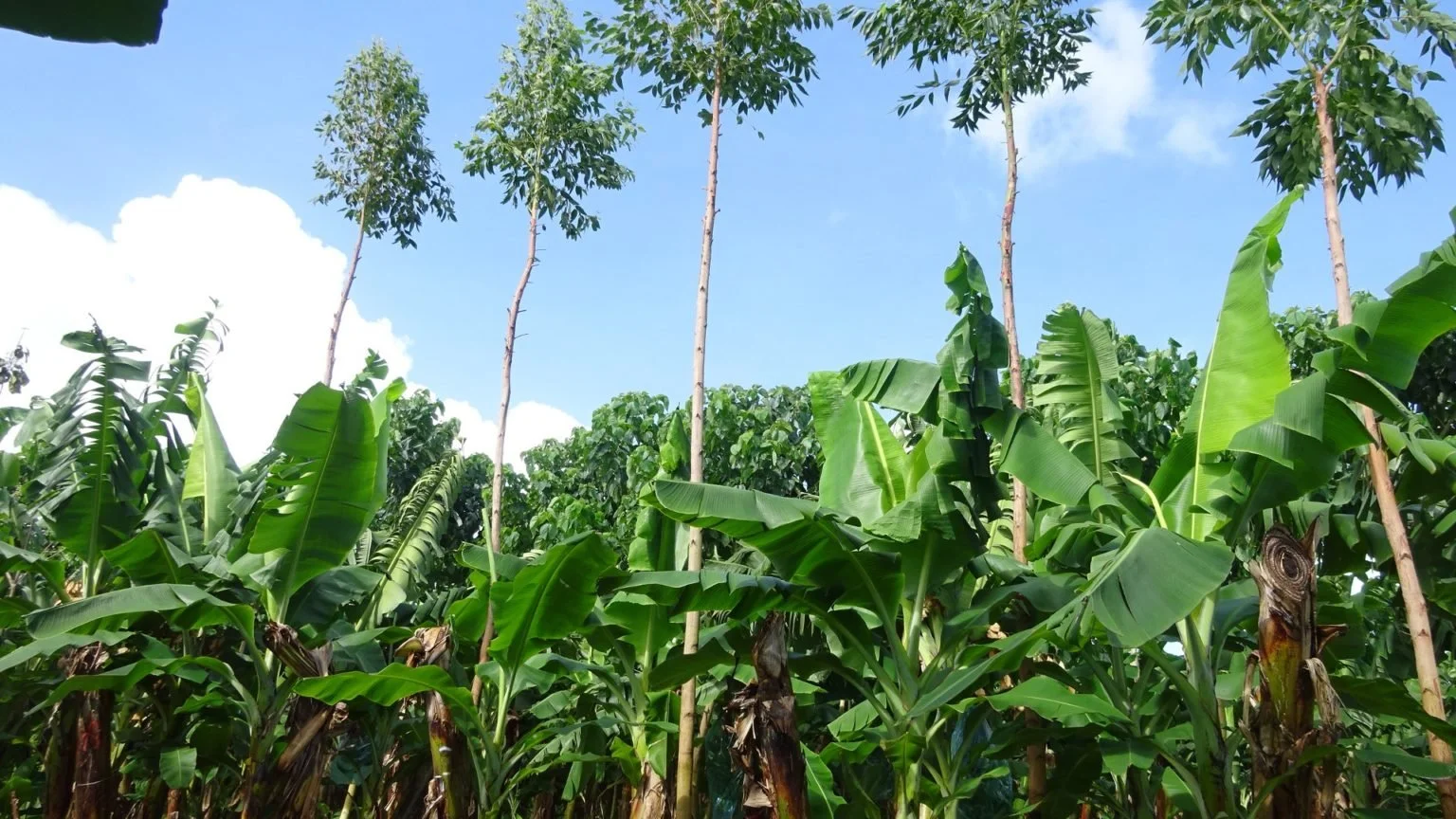Insights from Miyawaki Method and Syntropic Farming
Miyawaki forest at Arbor Road Estate, Telangana. Photo credit: Afforestt
Rows of Syntropic Farming at Sítio Semente, Brasília - DF. Photo credit: ecoportal.net
Our Food Forest Protocol is based on several experiences conducted at our Botanical Garden as well as on two well-known successional forestry and agroforestry practices. It combines elements of Miyawaki Mini Forest and of Ernst Götsch’s Syntropic Farming approach.
The Miyawaki Method: initially designed with the purpose of restoring degraded land by use of native vegetation, this method aims at creating ultra dense, biodiverse pocket forests that imitate the complexity of natural forests and the relationships and processes that help them grow strong and resilient. It is well documented scientifically, although it is not normally used for growing edible plants. At the Orchard of Flavours Botanical Garden, a first Miyawaki-inspired Food Forest was installed in July 2021.
Syntropic Agriculture: an exciting approach which is becoming more and more widely practiced in Portugal (as well as in many countries worldwide) in recent years. Its aim is to create a productive agroforestry system (or even an agroecosystem) which, when successfully executed, can truly strive while remaining independent of external material inputs. It recognizes ecological succession, while also mimicking natural stratification according to the sunlight requirements of each species. It can provide us with some really interesting insights and techniques.
Across this article, we will first attempt to summarise the key points of each approach, so we can look at their advantages and disadvantages and then draw conclusions.
Miyawaki forest near Shankarpally Hyderabad. Photo credit: Afforestt
Miyawaki Forest:
This technique was developed by the Japanese botanist and plant ecology expert Professor Akira Miyawaki and has been used and tested worldwide.
Objectives:
to create a forest efficiently and with rapid establishment, so it can quickly become self-sufficient (minimising human intervention and maintenance after the initial phase);
the direct effect of a Miyawaki forest is the creation of a green pocket of great biodiversity, composed of native species;
it can provide multiple benefits and many different applications depending on the placement, such as urban forests, windbreaks, dust barriers, noise barriers, wildlife habitat, etc;
the successful result of this method is an extremely fast growing forest due to the densely planted trees competing for light, the extensive soil preparation which allows for a very fast rooting and excellent capture of nutrients, and also the use of different layers of trees, which create a protective environment with less negative impact by frost, the wind or the extreme sun.
Method:
a method proven scientifically (lots of well-documented, peer-reviewed research and many experiments and applications all over the world);
the idea of natural succession of species is described as being essential to this method but it only includes perennial plants and no annual vegetables;
use of indigenous species with no direct aim at food production;
4 types of trees which correspond to 4 layers are distinguished: shrub, sub-tree, tree and canopy layers;
minimum 30 species: essential point to reach a high level of biodiversity;
Miyawaki forests are dense and multi-layered, being composed of different sizes of shrubs and trees. Picture credit: Afforestt
very intense initial preparation of the soil: very deep decompaction, lots of compost, manure and the introduction of beneficial fungi by use of a cocktail of mycorrhizal fungi;
mulching and systematic weeding for the first 3 to 4 years;
no pruning: the idea of succession is essential to this method but it is not controlled by human intervention (no species get proactively removed);
very dense planting: in temperate climates, 3 trees get planted per square meter, meaning that space between trees is 60cm;
random planting of the 4 layers, ideally by a kid! No predetermined layout and no lines are used, and therefore sometimes two big trees or two small shrubs are planted close to one another;
minimum size of around 10 square meters, otherwise no forest and biodiversity can sufficiently develop.
Advantages:
already proven and successful protocol: easy to understand and no complex, hard to follow rules and planning;
requires little maintenance once installed (after 3 to 4 years);
extremely fast growing due to competition for light and good soil preparation, helping to cover areas very quickly;
the high density enables you to grow fragile species which would otherwise be open to harsh elements (frost, wind, sun);
increased biodiversity of indigenous plants and a habitat for local fauna;
very few pest issues have been observed;
possibility of increased mycorrhizal activity and soil health (yet to be confirmed);
water saving (in our experience, each tree received 3 liters per day in case of extreme drought and heat). A tree planted separately would need a minimum of 6 liters in those same climatic conditions;
low death rate after one year, to be checked periodically.
Miyawaki forest implementation in Kanakakunnu, India. Photo credit: BemanHerish
The Orchard of Flavours’ 1st Miyawaki Food Forest experiment, 1 year after planting
Disadvantages:
very costly and labour intensive initially (though almost no work after 3 years);
this method was designed with a focus on indigenous plant species. The concept of indigenous is not an easy one and, in our opinion, it is to some extent an illusion. Also, due to climate change, non-indigenous species might sometimes be more suited;
the Miyawaki method was also designed with a focus on ecological restoration and not the production of food or materials. Hence, economic viability might be more difficult to achieve, when compared with a productive agricultural system;
since pathways are not usually designed into the system either, easy accessibility shouldn’t be expected;
it’s costly to do at a large scale.
Conclusions:
even though its initial establishment is quite costly and requires a lot of labour, the Miyawaki method provides an excellent (and proven) way to very quickly create little pockets of biodiversity in an orchard (among other places). The installation process is well documented and gives excellent results;
for a more in-depth study of Miyawaki Forests and Miyawaki-inspired Food Forests, please read the article we wrote describing the original method, the revised version according to the Orchard of Flavours mission and also the different Miyawaki Food Forest Experiments we already planted here in Luz de Tavira.
Syntropic Farming at Horta da Malhadinha in Mértola (both photos). Photo credit: Terra Sintrópica
Photo credit: Terra Sintrópica
Syntropic Farming:
This method was developed by Swiss farmer Ernst Götsch in Brazil and is now being adapted and applied in many countries.
Objectives:
to create diverse, highly productive and self-propelled agroforestry systems, which generate their own biomass, improve existing soil fertility and strive to regenerate the surrounding ecosystem as a whole;
being a versatile production-oriented method of agroforestry, its main outputs can include fruits, berries, vegetables, timber, fibers, fuel or other material goods;
this method attempts to mimic the dynamics found in healthy and complex natural systems so, as ecological benefits, successful Syntropic Farming practices can result in high carbon sequestration, improved soil fertility and water retention capability, higher biodiversity, among others.
Method:
an holistic approach based on the philosophy that nature is governed not by competition between species, but by principles of cooperation and unconditional love;
the idea of natural succession of species is core to this method, and efforts are made to accelerate this succession towards a system of abundance, a mature "climax" system, often compared to a primary forest;
also central to the Syntropic Agriculture method is the focus on maximizing photosynthesis. This is done by:
planting in high density;
distributing the different plants in the system according to their size and sunlight needs;
and carefully managing through pruning and “selective weeding” (removing plants which have fulfilled their function);
crucially, when planning a Syntropic Farming project, plants must be classified into two separate systems:
by duration of their life cycle: placenta, secondary and climax stages;
by sunlight needs: low, medium, high and emergent layers;
factors such as climate, latitude (existing sunlight) and available species must always be taken into account when designing a system, so one given plant might be classified differently according to the location of the farm;
no distinction tends to be made between indigenous and exotic species;
the interplanting of trees, shrubs, vines and vegetables is made according to the mentioned classifications, as well as the physical size of each plant throughout its life cycle;
research and observation is being carried out on these methods. It is not always well documented and is extremely complex;
the typical syntropic farm is designed with several linear rows of trees separated by about 4 meters. Between each two rows, market gardening can be practised, or cereal crops grown (at least in the first years);
some species (sometimes referred to as “biomass plants” or “martyr plants”) are used which do not need to produce any crops, but contribute positively to the system. Pruning of these plants is carried out systematically as a slash and mulch technique. In addition to allowing more light to lower level plants, pruning those “biomass plants” generates mulch and organic matter. This can help control weeds, feed the soil and keep it moist;
other plants are called “target trees” and produce a valuable harvest.
Advantages:
Syntropic Farming, veggies in between rows at Sitio Semente, Brasília - DF. Photo credit: ecoportal.net
all planting is carried out at one time, quickly establishing areas with a certain level of biodiversity;
planting in lines enables the use of modern machinery between the rows, increasing the productivity potential;
aims at providing food quickly and throughout the whole life of each tree line, starting with the short-lived “placenta” species, like annual veggies, and all the way until the long-term, most valued products, in the form of perennial crops (timber, nuts, fruit, fibers, etc);
already commonly practiced protocol, initially in tropical areas and being now more and more adapted to temperate climates as well, by increasing numbers of enthusiasts;
possibility of increased mycorrhizal activity and soil health (yet to be confirmed);
water saving (especially because of heavy mulching and density of planting);
great option for self-sufficiency or sales at the farm gate;
if successfully executed, Syntropic Farming practices can result in significant ecological benefits, such as high carbon sequestration, improved soil fertility and water retention capability, higher biodiversity, among others.
Disadvantages:
Syntropic Agriculture uses multiple complex concepts (the combination of 3 life cycles and 4 layers of trees, the concept of consociations of plants) which can make planning and executing very challenging tasks;
the syntropic protocol is very labour (and knowledge) intensive, both at the installation phase and thereafter;
the “biomass plants” (or “martyr plants”) are not always expected to bring an obvious valuable crop;
some of the pruning effects claimed by the Syntropic Farming approach do not yet seem well documented:
we think there is still not enough scientific evidence that the growth hormones of the pruned tree benefit other trees as often claimed;
there is, however, documented evidence that:
a pruned tree uses less water;
part of a tree's root system dies when pruned. But research shows that it regrows extremely fast;
photosynthesis is enhanced for the remaining leaves of a pruned tree;
pruning enhances activity of growth hormones which help trees develop strong new growth on the pruned parts;
A bird’s eye view over a Syntropic Farming productive system. Photo credit: Recicloteca
it is unclear if, after a few years, market gardening remains compatible between rows of well-developed trees. So, if the intention of the farmer is to keep growing annual vegetables (which means growing the “placenta” stage species), the syntropic approach forces you to expand to a new area after a couple of years;
in Syntropic Farming, it is actually recommended to plant tree rows up and down the slope instead of following the landscape contour lines. We hear it’s a way for each tree to have more light and enhance photosynthesis. But what about the risk of erosion, and the loss in water infiltration?
because of its complexity, adapting this method to different climates and different communities of plants can be quite challenging for new enthusiasts outside of its birthplace, in Brazil.
Conclusions:
the increasing wave of enthusiasts and practitioners of Syntropic Farming around the world is showing how exciting and dynamic it can be, as an approach to growing highly productive systems that replicate the potential for regeneration and growth that we find in natural systems;
however, and even though there’s no denying the real potential for high production output of syntropic systems, it’s also true that there are huge input requirements in terms of both labour and knowledge, especially taking into account the complex concepts involved in planning, executing and maintaining a system with so many moving parts, across time and space;
at the Orchard of Flavours, although you won’t be finding any truly syntropic lines, we still decided to adopt a couple of the central concepts in Syntropic Agriculture into our own experiments;
so in our Food Forest Protocol, we added “biomass plants” (we call them “Hero Trees”), which will bring density and diversity into our orchard. We will then be systematically pruning them in order to bring light into the system, and life into the soil. Naturally, since this is the Orchard of Flavours, our Hero Trees will always be fruit trees or other edible plants.
for a more in-depth study of Syntropic Farming, please visit:
there are also really wonderful projects in Portugal where hard-working folks are doing a great job of adapting Ernst Götsch’s approach to our temperate climate:
Centro de Agroecologia de Mértola / Horta da Malhadinha, Mértola
Quinta das Abelhas, Montemor-o-Novo
A Syntropic Farming line of trees and banana plants. Photo credit: Wikifarmer
This article was written by Miguel COTTON, Jackson KNIGHTS & Miguel PEREIRA. If you have any questions or suggestions, do not hesitate to contact us. Please write us anytime at miguel@orchardofflavours.com.

